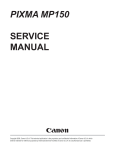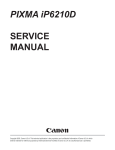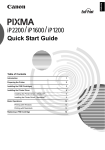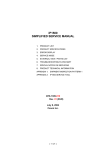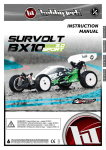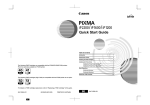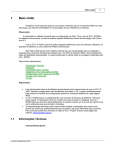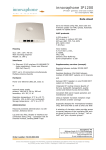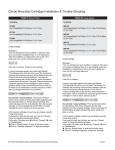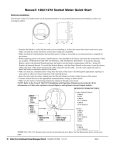Download Canon iP1200 Service manual
Transcript
PIXMA iP1600 SERVICE MANUAL Canon Copyright 2005, Canon U.S.A. This technical publication is the proprietary and confidential information of Canon U.S.A. which shall be retained for reference purposes by Authorized Service Facilities of Canon U.S.A. Its unauthorized use is prohibited. iP2200 / iP1600 / iP1200 SIMPLIFIED SERVICE MANUAL 1. PRODUCT LIST 2. PRODUCT SPECIFICATIONS 3. ERROR DISPLAY 4. SERVICE MODE 5. EXTERNAL VIEW / PARTS LIST (for Asia) 7. SPECIAL NOTES ON SERVICING 8. PRODUCT TECHNICAL INFORMATION APPENDIX 2: iP2200 / iP1600 / iP1200 SERVICE TOOL QY8-13AA-000 Rev. 00 June 30, 2005 Canon Inc. (1/23) 1. PRODUCT LIST 1-1. Main Units iP2200 product code iP1600 product code iP1200 product code Sales territories 9989A001AA US 9990A002AA 9989A002AA CA 9990A003AA 9989A003AA 0196B003AA LAM LVT 9990A004AA 9989A004AA 0196B004AA LAM HVT 9990A006AA 9989A006AA 0196B006AA EUM 9990A007AA 9989A007AA 0196B007AA EMB 9990A008AA 9989A008AA 0196B008AA ASA HVT 9990A009AA 9989A009AA 0196B009AA AU 9990A010AA 9989A010AA 0196B010AA KR 9990A011AA 9989A011AA 0196B011AA GB 9990A012AA Remarks JP 0196B013AA TW 9990A014AA 9989A014AA 0196B014AA HK 9990A015AA 9989A015AA 0196B015AA CN 0196B016AA MY 1-2. Options None 1-3. Consumables Product name Product code Sales territories Remarks Canon FINE Cartridge PG-40 0615B001AA to 0615B005AA 001: EUR CL-41 0617B001AA to 0617B005AA 002: AMR PG-50 0616B001AA to 0616B005AA CL-51 0618B001AA to 0618B005AA BC-70BK 0390B001AA BC-71CL 0392B001AA BC-90BK 0391B001AA BC-91CL 0393B001AA Other than Japan 003: ASIA 005: AMR S Japan only (2/23) 2. PRODUCT SPECIFICATIONS 2-1. Printer Main Unit Specifications Paper feeding method Resolution Printing speed Printing direction Fast mode print duty Print width Interface Supported ink cartridge No. of pages that can be printed ASF stacking capacity Paper weight Plain paper High Resolution Paper Glossy Photo Paper Photo Paper Pro, Photo Paper Plus Glossy, Matte Photo Paper Photo Paper Plus Double Sided Photo Paper Plus Semi-gloss Transparency Envelope T-shirt Transfer Photo Stickers Borderless printing Detection function Cover open Presence of ink cartridge Presence of ink Presence of paper Paper width Waste ink absorber full Internal temperature Remaining ink amount Print head alignment Acoustic noise level Fine (Photo Paper Pro / Fine mode) HQ ASF 4,800 x 1,200 dpi (max.) iP2200: Approx. 55 sec. (PP-101, 4 x 6, borderless printing, default print quality) iP1600, iP1200: Approx. 70 sec. (PP-101, 4 x 6, borderless printing, default print quality) For reference: Fast Standard iP2200: Black 22 ppm 13.4 ppm Color 17 ppm 7.8 ppm iP1600: Black 19 ppm 13.4 ppm Color 16 ppm 7.8 ppm iP1200: Black 11 ppm 5.1 ppm Color 11 ppm 4.2 ppm Bi-directional / Uni-directional (automatically switched according to print data and print mode) 50% duty 203.2 mm (216 mm in borderless printing) USB (2.0) Full Speed only Consumable BK: 2,000 pages (1,500 character pattern) CL: 1,600 pages (7.5% duty per color pattern) 80 pages (A4, photo, borderless printing) 200 pages (4x6, photo, borderless printing) 120 pages (Postcard, photo, borderless printing) Max. 10 mm (Approx. 100 pages of 75 g/m2) 64 to 105 g/m2 10 mm or less 10 mm (Approx. 80 sheets) or less A4, LTR: 10 sheets or less 4x6: 20 sheets or less A4, LTR, 5x7: 4x6, 4x8: 10 sheets or less 20 sheets or less 1 sheet A4, LTR: 10 sheets or less 4x6: 20 sheets or less 30 sheets or less 10 sheets or less 1 sheet 1 sheet Up to A4, LTR Available Available Available Available Not available Available Available Available (Detected by dot counting) Available (12 types) Approx. 44 dB (Sound pressure level ISO9296) Approx. 46 dB (3/23) HS iP2000, iP1600: Approx. 58 dB iP1200: Approx. 56 dB Environmental requirements During operation Temperature: Humidity: Temperature: Humidity: Non-operation 5C to 35C (41F to 95F) 10% to 90%RH (no condensation) 0C to 40C (32F to 104F) 5% to 95%RH (no condensation) Power supply Input voltage / Frequency Power consumption: During printing Stand-by status External dimensions Weight Related standards Electromagnetic radiance, Electrical safety AC 100 to 240 V, 50/60Hz Approx. 10 W Approx. 1 W iP2200: - With the paper support extended: Approx. 435 (W) x 280 (D) x 259 (H) mm - With the paper support retracted: Approx. 435 (W) x 253 (D) x 165 (H) mm iP1600, iP1200: - With the paper support extended: Approx. 435 (W) x 277 (D) x 259 (H) mm - With the paper support retracted: Approx. 435 (W) x 249 (D) x 165 (H) mm Approx. 2.9 kg (excluding the ink cartridges) VCCI, FCC, IC, CE Mark, Taiwan EMC, C-Tick, CCC (EMC), Korea MIC, Gost-R, DENAN, UL, C-UL, CB Report, GS, FT, SASO, SPRING, Korea EK, IRAM (Argentine) Note: Not Blue Angel compliant. <Difference between the iP2200, iP1600, and iP1200> Ink cartridges Housing Model (main cover configuration) Standard Optional iP2200 2 parts PG-40, CL-41 PG-50, CL-51 iP1600 1 part PG-40, CL-41 --iP1200 1 part CL-41 PG-40 Throughput iP2200 > iP1600 > iP1200 2-2. Product Life Specified print volume or the years of use, whichever comes first. - 3 years of use - Print volume: 4,000 pages - Black: 2,000 pages (A4, standard mode, 1,500 character pattern) - Color: 1,600 pages (A4, 7.5% duty per color pattern) 80 pages (A4, photo, borderless printing) 200 pages (4 x 6, photo, borderless printing) 120 pages (Postcard, photo, borderless printing) Note: The above print volume breakdown is estimated using average user consumption patterns of printing 4,000 pages. 2-3. Ink Cartridge Specifications Ink cartridge Type Ink-tank-integrated print head Print head Bk: 320 nozzles in 2 vertical lines C/M/Y: 192 nozzles in 2 vertical lines per color Ink droplet: Bk 30 pl, CL 5 pl / 2 pl Ink color Bk (pigment-based pearl), C/M/Y (super dye-based) Weight PG-40 approx. 43 g, CL-41 approx. 45 g PG-50 approx. 51 g, CL-51 approx. 56 g Supply method As a consumable (4/23) <Supported ink cartridges by models> Ink cartridge Model iP2200 iP1600 iP1200 Standard PG-40 (BK) CL-41 (CL) Standard package Standard package Standard package Usable as an option High capacity PG-50 (BK) CL-51 (CL) Usable as an Usable as an option option Not usable Not usable Not usable Not usable Standard package Standard package <Ink cartridge (ink tank with the nozzles) yield> Units: pages iP2200 PG-40 1,500 character pattern plain paper / standard mode (BK) ISO JIS-SCID No. 5 plain paper / standard mode (BK) ISO JIS-SCID No. 5 plain paper / standard mode (CL) Digital camera 24 images PP-101 4x6 CL-41 iP1600 PG-50 CL-51 PG-40 490 750 490 760 1,170 760 iP1200 CL-41 CL-41 430 ----- 190 320 190 180 100 180 100 100 (5/23) 3. ERROR DISPLAY Errors are displayed by the LEDs, and ink low warnings are displayed by the Status Monitor. 3-1. Operator Call Error (Alarm LED Blinking in Orange) Alarm LED Error Corrective action blinking 2 times No paper Set paper, and press the Resume/Cancel button to feed the paper. 3 times Paper jam Remove the jammed paper, and press the Resume/Cancel button. 4 times No ink Replace the ink cartridge(s), or press the Resume/Cancel button to continue printing without replacing the ink cartridge(s). 5 times The ink cartridges are not properly Install the ink cartridges properly. installed, or a non-supported ink cartridge Or, confirm that the supported ink cartridges are is installed (the ink cartridge EEPROM installed. data is abnormal). 7 times Ink cartridge not installed Install the ink cartridge(s), and close the access cover. 8 times Waste ink absorber full or platen waste ink Pressing the Resume/Cancel button will exit the absorber full warning (approx. 95% of the error, and enable printing. maximum capacity) 14 times Non-supported ink cartridge installed Replace the non-supported ink cartridge with the supported one. 16 times Used ink cartridge installed, or no ink Pressing the Resume/Cancel button will exit the error, and enable printing. 3-2. Service Call Error (Cyclic Blinking in Orange (Alarm LED) and Green (Power LED)) Cycles of blinking in orange and Error Corrective Action green 2 times Carriage error Replace the printer as it has failed. 3 times LF error Replace the printer as it has failed. 7 times Waste ink absorber full or platen waste ink Replace the printer as it has failed. absorber full 8 times Print head temperature rise error Replace the printer as it has failed. 9 times EEPROM error Replace the printer as it has failed. 10 times No ink cartridge detected excepting ink Replace the printer as it has failed. cartridge replacement (during printing) (6/23) 3-3. Ink Low Warning (Ink low warnings are displayed by the Status Monitor only when the remaining ink level detection is enabled, and no Status Monitor display when disabled.) Note: The Status Monitor display in the table below is for Windows. Warning Display by Status Monitor Ink low warning 1 (approx. 70% of ink remaining) Ink low warning 2 (approx. 40% of ink remaining) Ink low warning 3 (low remaining ink) Ink low warning 4 (no ink remaining) (7/23) 4. SERVICE MODE To conduct the following functions, a host computer (Windows 98 / ME / 2000 / XP), printer driver and service tool (QY9-0068) for the iP2200, iP1600, and iP1200 are needed (though the stand-alone print function is available). If an error has occurred in the printer, the service tool cannot be used as it is. To use the service tool, set the printer in the special mode, following the procedures below. <Special mode setting procedures> With the ink cartridges installed, while pressing and holding the Power button, connect the AC plug. After the Power LED lights in green, with the Power button still pressed, press the Resume/Cancel button 2 times, and release both the Power and Resume/Cancel buttons. (Each time the Resume/Cancel button is pressed, the Alarm and Power LEDs light alternately, Alarm in orange and Power in green, starting with Alarm LED.) Function Print head manual cleaning <For reference> Print head deep cleaning Paper feed roller cleaning Procedure Remarks Select “Cleaning” from the printer driver Maintenance. Cleaning time: Approx. 40 sec. Select “Deep Cleaning” from the printer driver Maintenance. Cleaning time: Approx. 60 sec. Cleaning time: Approx. 2 min. 1. Remove the paper from the ASF. Host computer is required. 2. Select “Roller Cleaning“ from the printer driver Maintenance. 3. Following the instruction from the Status Monitor, load 3 sheets of plain paper in the ASF, and feed them. Test printing 1) Nozzle check pattern printing Select “Nozzle Check“ from the printer driver Maintenance. <For reference> 1. Select “Print Head Alignment“ from the printer driver Print head alignment Maintenance. 2. Select the optimal value using the printed head position adjustment pattern. Nozzle check pattern printing Significant misalignment can be adjusted. Host computer is required. Refer to Shipment inspection pattern*1 below. 2) Shipment pattern printing - ROM version - Number of pages fed - Waste ink amount EEPROM reset Refer to EEPROM reset / Destination setting*3 below. (Reset of waste ink counter etc.) Destination setting Refer to EEPROM reset / Destination setting*3 below. EEPROM information check Stand-alone printing Refer to Shipment inspection pattern sample*2 below. Host computer and service tool are required. Host computer and service tool are required. Host computer and service tool are required. Refer to Shipment inspection pattern sample*2 below. Host computer and service tool are required. Host computer and service tool 1. Set paper. 2. In the stand-by mode, press the Resume/Cancel button NOT required. 5 times in 2 seconds. <Conditions> - At “no paper” error, turn the printer off, and turn it on again, before doing the stand-alone printing. - Even in the stand-by mode, if the printer enters the power-saving mode (10 seconds after capping), the stand-alone printing cannot be done. *1 Shipment inspection pattern printing a. Install the ink cartridge, and press the Power button to turn on the printer. (The Power LED lights in green.) b. Set A4-sized paper. c. Connect the printer to the computer. Using the iP2200 / iP1600 / iP1200 service tool (QY9-0068), select “USB PORT.” (See APPENDIX 2, iP2200 / iP1600 / iP1200 SERVICE TOOL.) d. Select “TEST PATTERN 1.” The printer starts printing the shipment inspection pattern. (8/23) *2 Shipment inspection pattern sample EEPROM contents can be confirmed from the shipment inspection pattern printout (top of the shipment inspection pattern). See APPENDIX 1, SHIPMENT INSPECTION PATTERN 1, for print sample. *3 EEPROM reset / Destination setting a. Install the ink cartridge, and press the Power button to turn on the printer. (The Power LED lights in green.) b. Connect the printer to the computer. Using the iP2200 / iP1600 / iP1200 service tool (QY9-0068), select “USB PORT”. (See APPENDIX 2, iP2200 / iP1600 / iP1200 SERVICE TOOL.) c. <Destination setting> Destination can be set by clicking “LOCK RELEASE,” then each model name in “SET DESTINATION.” Confirm the model name by clicking “GET DEVICE ID” after setting change. (If incorrect, it can be changed before turning the unit OFF/ON.) <EEPROM reset> When ”EEPROM CLEAR” is checked, the EEPROM is reset after the shipment inspection pattern printing. (9/23) 5. EXTERNAL VIEW / PARTS LIST (for Asia) 5-1. External Parts, Power Supply Unit, Logic Board Ass’y 5-2. Print Unit (10/23) Parts List Key 1 Part Number Rank Q’ty QC1-6119-000 J 1 Description ASF COVER Remark Common parts iP2200 QC1-6092-000 J 1 ASF COVER iP1600, iP1200 QC1-6024-000 J 1 ACCESS COVER (E) iP2200 QC1-6142-000 J 1 ACCESS COVER (J) iP2200 QC1-6093-000 J 1 ACCESS COVER iP1600, iP1200 QC1-6025-000 J 1 FRONT PANEL iP2200 QM2-2139-000 J 1 MAIN COVER UNIT iP2200 QM2-2125-000 J 1 MAIN COVER UNIT iP1600, iP1200 QC1-5005-000 J 1 EMBLEM (E) QC1-5009-000 J 1 EMBLEM (J) 6 QM2-2776-000 I 1 LOGIC BOARD ASS’Y 7 QC1-6015-000 I 1 TIMING SLIT STRIP FILM Y 8 QC1-6016-000 I 1 TIMING SLIT STRIP FILM SPRING Y Y 2 3 4 5 Y Y 9 QM2-2137-000 J 1 CAP BLADE UNIT 10 QC1-6021-000 J 1 CAP SLIDE SPRING Y 11 QC1-6033-000 I 1 INK ABSORBER Y 12 QC1-6034-000 I 1 INK ABSORBER L Y 13 QC1-6088-000 I 1 INK ABSORBER R Y 14 QC1-6014-000 I 1 PLATEN ABSORBER Y QK1-1543-000 I 1 AC ADAPTER: 100/240V 50/60HZ QK1-1540-000 I 1 AC ADAPTER: 100/240V 50/60HZ iP1600, iP1200 QC1-6108-000 G SCREW, B-TIGHT M3x44 For main chassis to separation base Y Y 15 S1 iP2200 S2 XA9-1493-000 G SCREW, TP M3x8 For base, main chassis, LF side plate S3 XB1-2200-505 G SCREW, MACH, TRUSS HEAD M2x5 For LF sensor to LF sensor plate Y S4 XB1-2260-305 G SCREW, MACH, TRUSS HEAD M2 6x3 For main chassis to LF motor Y S5 XB1-2300-605 G SCREW, MACHINE M3x6 For PE sensor to main chassis Y S6 XB6-7300-605 G SCREW, TP, M3x6 For power supply, LF sensor plate Y Power cables: QH2-2720-000 S 1 CORD, POWER 120V (LAM-LV) QK1-0286-000 S 1 CORD, POWER 100V-120V (JP) QK1-0278-000 S 1 CORD, POWER 100V-120V (US) QK1-2017-000 S 1 CORD, POWER 100V-120V (TW) Y QK1-0279-000 S 1 CORD, POWER 220V-240V (EUR) Y QK1-1061-000 S 1 CORD, POWER 220V-240V (AU) Y WT3-5156-000 S 1 CORD, POWER 220V-240V (GB, HK) Y WT3-5160-000 S 1 CORD, POWER 220V-240V (KR) Y WT3-5182-000 S 1 CORD, POWER 220V-240V (CHN) Y Y: In common with the iP2200, iP1600, and iP1200 (11/23) Y Y 6. TROUBLESHOOTING FLOWCHART 6-1. Printer Main Unit Troubleshooting Flowchart (how to confirm printer operation at refurbishment) Power ON Service Call Error? Yes No Open access cover, and install print head Service Call Error? Yes No Connect to computer Shipment inspection pattern printing Correct? Yes < Shipment inspection pattern check items> (See APPENDIX 1, SHIPMENT INSPECTION PATTERN 1.) See 4. SERVICE MODE for printing method. 1. Non-ejection of ink: 2. Top of form: 3. Vertical lines: 4. Gray area: No Replace print head and print shipment inspection pattern Correct? Yes Off the paper Not connected White lines / uneven density No Yes Main waste ink counter less than 7%? Yes No Visually check the platen waste ink absorber, and replace it if it is soiled. Normal Defective <Note for normal printer refurbishment> At end of refurbishment, set the printer to the default shipment conditions (with the paper lifting plate in the raised position, and the carriage locked in the home position), following the steps below. 1. Install the ink cartridges, and while pressing and holding the Power button, connect the AC plug. After the Power LED lights in green, with the Power button still pressed, press the Resume/Cancel button 2 times, and release both the Power and Resume/Cancel buttons. (Each time the Resume/Cancel button is pressed, the Alarm and Power LEDs light alternately, Alarm in orange and Power in green, starting with Alarm LED.) 2. Print the shipment inspection pattern, and reset the EEPROM, following the procedures in 4. SERVICE MODE. 3. Press the Power button to turn off the printer. (The paper lifting plate is raised, and the carriage moves to the print head replacement position.) Remove the ink cartridges. (DO NOT print after this point.) (12/23) NG NG NG NG 6-2. Ink Cartridge Troubleshooting Flowchart (ink cartridge operation confirmation) Connect to computer Nozzle check pattern printing See 4. SERVICE MODE for printing method. Yes Correct? No See 4. SERVICE MODE for cleaning method. Ink cartridge cleaning Nozzle check pattern printing Yes Correct? No Ink cartridge deep cleaning See 4. SERVICE MODE for cleaning method. Nozzle check pattern printing Correct? Yes No Ink cartridge deep cleaning Nozzle check pattern printing Correct? Yes No Replace ink cartridges Nozzle check pattern printing Correct? Yes No Normal Defective (13/23) 7. SPECIAL NOTES ON SERVICING 7-1. Resetting the Main and Platen Waste Ink Counters The counters for the main waste ink absorber and the platen waste ink absorber can be reset separately. At waste ink absorber replacement, using the iP2200 / iP1600 / iP1200 service tool, reset the applicable waste ink counter(s). (When both the main and platen waste ink absorbers are replaced, reset both the main and platen waste ink counters.) If an error has occurred in the printer, the service tool cannot be used as it is. To use the service tool, set the printer in the special mode, following the “special mode setting procedures” in 4. SERVICE MODE. <Waste ink absorber replacement procedures> 1. Error check At a waste ink full error (95% or full), identify which waste ink absorber is full, the main or the platen, using the iP2200 / iP1600 / iP1200 service tool’s EEP-ROM INFORMATION, Dd or Ds values, as the error itself does not indicate which waste ink absorber is full. (See APPENDIX 2, iP2200 / iP1600 / iP1200 SERVICE TOOL, for details). Then, replace the applicable waste ink absorber. - Dd: Main waste ink absorber amount (120,080 mg at 95% full, 126,400 mg at full) - Ds: Platen waste ink absorber amount (17,955 mg at 95% full, 18,900 mg at full) 2. Resetting the replaced waste ink absorber counter - At main waste ink absorber replacement: In the iP2200 / iP1600 / iP1200 service tool CLEAR WASTE INK COUNTER section, click MAIN to reset the main waste ink counter value. - At platen waste ink absorber replacement: In the iP2200 / iP1600 / iP1200 service tool CLEAR WASTE INK COUNTER section, click PLATEN to reset the platen waste ink counter value. 7-2. Servicing in Asia - Elimination of Major Component Connectors on the Logic Board Ass’y In the models (iP2200, iP1600, and iP1200), the PE sensor, ASF sensor, and LF encoder sensor are soldered to the logic board ass’y; thereby, the connectors which were used in prior models are eliminated. <Special notes on servicing> In replacing the logic board ass’y, remove the solder from the PE sensor, ASF sensor, and LF encoder sensor cable connections, and re-solder them to the replaced logic board ass’y. Logic Board Ass’y (14/23) (15/23) 8. PRODUCT TECHNICAL INFORMATION 8-1. FAQ (Problems specific to the iP2200, iP1600, and iP1200, and their corrective actions) No. 1 * A 2 A 3 B 4 5 Function Phenomenon Possible Call / Claim Corrective action Installation Carriage error (Alarm and Power - The LEDs blink alternately in orange Remove the packing material fixing the and green, 2 times (carriage error). carriage. LEDs blink alternately 2 times). Ink cartridge installation error (Alarm LED blinks in orange 5 times.) Cause The user may not have removed the packing material at unpacking and installation. Note: Even if the packing material remains, no parts are damaged. Open the access cover, and install the ink The user did not install the ink cartridges - LED blinks in orange 5 times (ink completely at unpacking, installation, or cartridge installation error). (As this cartridge(s) properly. ink cartridge replacement. occurs at printer installation, the user A non-supported ink cartridge is installed. cannot recognize the error.) No paper feeding (Inkjet postcard) - Paper out error - Paper cannot be fed - Cannot print C Multi-feeding - Multiple sheets of paper are fed simultaneously. -Blank paper is ejected. B Envelope not feeding - Paper out error - Paper cannot be fed - Cannot print Paper feeding 1. Perform roller cleaning from the printer driver. 2. Clean the paper feed roller with pre-moistened wipe or moistened cloth. 1. Fan the paper and set them in the ASF. 2. In case of PR-101, set the paper sheet by sheet in the ASF. 1. 2. 3. 6 C Paper jam 4. 1. - Paper jam error - Paper cannot be fed - Cannot print (16/23) The paper feed roller slips on the paper at paper feeding. In the high temperature and high humidity environment, the frictional force between the front and back sides of paper becomes high, and sheets stick to each other, contributing to multi-feeding. Perform roller cleaning from the printer The paper feed roller slips on the paper at paper feeding. driver. Note: Depending on the paper lots. Clean the paper feed roller with pre-moistened wipe or moistened cloth. Reduce the number of envelopes loaded in the ASF. Flatten the envelope (with a pen). Remove the jammed paper from the As the LF roller slips on the paper, the paper pick-up side. paper is not fed, causing the jam error at paper ejecting. (8-1. FAQ (Problems specific to the iP1000 and corrective actions) cont’d) No. 7 * B 8 Function Image quality Phenomenon Smearing on printed side. Possible Call / Claim - Smear on the printed side of paper - Cannot print properly - Paper edge crease B Smearing on the backside, or address side of postcards 9 C Horizontal lines or uneven print density at the trailing edge of paper <Photo Paper Plus Double Sided> - Smears on the already printed side when printing the other side <When printing the address side of postcards> - Smears on the address side <When printing the message side of postcards> - Smears on the backside 1. Recommend printing in the print - Cannot print to the bottom edge of quality assurance area. paper - Lines or uneven print density appear 2. Change the print quality from Standard to High mode. in the trailing edge of paper 3. Try other paper (PP-101) - Cannot print properly 10 C Horizontal lines or uneven print density due to LF roller feeding at small pitch - Lines or uneven print density (on skin tones and background) - Cannot print properly Corrective action 1. Correct the paper curl. 2. Recommend the user to conduct printing in the print quality assurance area. 1. Perform bottom plate cleaning from the printer driver. 2. Clean the ribs on the platen with cotton swabs/buds. When the paper end comes off the pinch roller, printing is performed without the paper being held, preventing the ink drops from being ejected in the correct positions, resulting in unevenness. Note: The problem is less noticeable than that of the iP1500. As the print media slightly slips while 1. Perform print head alignment. 2. Change the print quality from Standard being fed by the LF roller, printed areas overlap, causing the problem. to High mode. *Occurrence level: A: The phenomenon is likely to occur frequently. (Caution required). B: The phenomenon may occur under certain conditions, but likeliness is assumed very low in practical usage. C: The phenomenon is unlikely to be recognized by the user, and no practical issues are assumed. (17/23) Cause The edge of paper rises due when paper is curled, causing the ink cartridge to rub against the printed surface of paper, resulting in smearing. When borderless printing is conducted continuously, ink mist attaches to the ribs on the platen, and is transferred to the backside of the following paper. 8-2. Major Functions (1) Paper thickness lever (at the bottom front of the printer) The head-to-paper distance can be adjusted using the paper thickness lever. <Possible problems with this function> - The ink cartridge rubs against the paper when the amount of paper curl is large. -> Flatten curled paper (to less than 3 mm). -> In print modes other than borderless printing, conduct printing in the print quality assurance area of the top and bottom edges. (Top margin 38.3 mm, bottom margin 31.2 mm) (2) Quiet mode The printer has a quiet mode function. Compared with the normal mode, Acoustic noise level: Slightly lower. (HQ normal approx. 43.7 dB, Quiet approx. 42.8 dB) Audible overtone level: Sound quality changes, and sound becomes quieter. Print speed: Slows. <Possible problems with this function> - The operation sound does not become quieter. -> The audible sound becomes only slightly quieter. - Printing is slow. -> Disable the Quiet mode. (3) Remaining ink level detection function The printer has a function to detect the remaining ink level. Detection method: Dot counting (Counted for each BK/CL ink cartridge) CL cartridge: The remaining ink level is detected by total counted dot values of 3 colors of ink. Display method: Displayed on the Status Monitor (at 4 levels listed below for each BK/CL ink cartridge) Level 1: Approx. 70% of ink remaining Level 2: Approx. 40% of ink remaining Level 3: Indication of “!” mark (Remaining ink level is low) Level 4: Indication of “X” mark (No ink remaining) Note: Remaining ink detection function displays the status only, and does not cause errors. Accuracy: The margin of error of detection accuracy is +/-10% in normal printing. The margin of error is likely to be large in the following specific print patterns: When printing continuously using any one of the CMY colors of ink -> As the remaining ink level is calculated by the counted dot value of the least remaining ink of 3 colors, if any of the C/M/Y inks is heavily consumed, the margin of error for remaining ink increases. When performing continuous BK solid printing -> With continuous printing, ink flow from the tank to the ink chamber can be interrupted, after which ink remains unused in the tank. <Possible problems with this function> - When a once-used ink cartridge is installed, the actual remaining ink level is not detected, and an error indicating the remaining ink amount is unknown occurs. Pressing the Resume/Cancel button will clear the error, and printing can be done. However, the function to detect the remaining ink amount is disabled (ink status is not displayed). e.g.: An ink cartridge was once used in another printer. (18/23) A current ink cartridge is removed from the printer. -> A new ink cartridge is installed. -> The removed ink cartridge is installed again after removing the new ink cartridge. - Due to the specific print pattern, the actual remaining ink level does not match the indicated remaining ink level. This is because a detection error can be large in specific print patterns (such as continuous printing using any one of the CMY colors of ink or continuous solid printing, etc.). (4) Start of printing before receipt of the complete print data The printer RAM is not enough to store the complete print data for 1 scanning, so printing starts before the entire print data for 1 scanning is stored in the buffer. <Possible problems with this function> - Printing is slow. - Lines or streaks appear on printouts. -> Increase the print quality (from Standard to High). (5) Deep cleaning The printer has a deep cleaning (refreshing) function. Deep cleaning (refreshing): This is a deep cleaning function in order to resolve print failure due to ink clogging the nozzles. (The black ink is pigment-based, and clogs easier than other dye-based ink.) Perform from the printer driver Maintenance. <Possible problems with this function> - Excessive ink consumption when conducting deep cleaning repeatedly. (The amount of ink used is approx. 4 times the normal manual cleaning amount.) <Reference> Cleaning types, amount of ink used, and time required Cleaning type Amount of ink used Manual cleaning Dot count cleaning BK: Approx. 0.10 g Timer cleaning (24 hours to 2 months) CL: Approx. 0.10 g CL ink cartridge replacement Cleaning on arrival at user BK ink cartridge replacement BK: Approx. 0.15 g Timer cleaning (2 to 3 months) CL: Approx. 0.15 g Cleaning when the print head is not capped at printer power on Timer cleaning (3 to 6 months) BK: Approx. 0.30 g CL: Approx. 0.30 g Deep cleaning BK: Approx. 0.45 g Timer cleaning (6 months or more) CL: Approx. 0.45 g Time required Approx. 40 sec. Approx. 45 sec. Approx. 55 sec. Approx. 60 sec. (6) Print head alignment The printer has a print head alignment function (print head position adjustment function). As it is not necessary to perform print head alignment at setup or installation of the printer, the function is only briefly introduced at installation. Print head alignment: This is a function to correct displacements between the nozzle lines of the print head, and incorrect print position at bi-directional printing. The adjustment is conducted using the printed head position adjustment pattern. A: Alignment of cyan nozzle inclination (19/23) B: Alignment of cyan large nozzles in bi-directional printing C: Alignment of cyan small nozzles in bi-directional printing D: Alignment between cyan large and small nozzles E: Alignment of magenta large nozzles in bi-directional printing F: Alignment of magenta small nozzles in bi-directional printing G: Alignment between magenta large and small nozzles H: Alignment between black even and odd nozzles I: Alignment of black nozzle inclination J: Alignment of black nozzles in bi-directional printing K: Horizontal alignment between CL and BK chips L: Vertical alignment between CL and BK chips M: Alignment of yellow large nozzles in bi-directional printing N: Alignment of yellow small nozzles in bi-directional printing O: Alignment between yellow large and small nozzles Perform from the printer driver Maintenance. (At initial set-up by the user, notice to perform the print head alignment is displayed in the Status Monitor.) <Possible problems with this function> - The line is not straight. -> Perform print head alignment from the printer driver. - Printout is granulated. -> Perform print head alignment from the printer driver. (20/23) APPENDIX 1: SHIPMENT INSPECTION PATTERN 1 Check item 1 (Non-ejection of ink): Total area of the sample below Check item 2 (Top of form) EEPROM information print (A) -> See below for details. BK nozzle check pattern C nozzle check pattern 5pl M nozzle check pattern 5pl Y nozzle check pattern 5pl C nozzle check pattern 2pl M nozzle check pattern 2pl Y nozzle check pattern 2pl Check item 3 (Gray area) Check item 4 (Vertical lines) EEPROM information print (B) -> See below for details. Paper size: A4 <EEPROM information print> Model name (A) ROM version IP1500 P=V X.XX Dd=XXX.X Ds=XXX.X Page=XXXX BL=XXXX YY YY YY YY USB= (YYYYYY) Platen ink absorber waste ink amount (%) Main ink absorber waste ink amount (%) (B) Dd=XXX.X Ds=XXX.X Page=XXXX PL=XXXX , PR=XXXX , CA=XXXX , BL=XXXX SettingTime=XXXX / XX / XX XX:XX Installation time (21/23) Number of sheets fed Page: Total PL: Plain paper PR: PR-101, PP-101, MP-101 CA: Postcard, inkjet postcard, glossy photo card BL: Borderless printing (counted separately from the count by paper type) APPENDIX 2: iP2200 / iP1600 / iP1200 SERVICE TOOL <How to use the iP2200 / iP1600 / iP1200 Service Tool (QY9-0068)> Usage: Shipment inspection pattern printing Destination setting in EEPROM EEPROM reset Supported OS: Windows 98 / ME / 2000 / XP (J/E version) : QY9-0068 Distribution method: Provided by SSIS (Download “iP2200 / iP1600 / iP1200 Service Tool” from software download in SSIS.) <Usage procedures> 1. Unzip iP2200_iP1600_iP1200ServiceTool.zip. (Double-click to unzip the file.) 2. Open the iP2200_iP1600_iP1200ServiceTool folder created after unzipping. 3. Open GeneralTool.exe. A B F G C2 D H E C1 4. Select the connected USB port number from USB PORT (A). <How to print the shipment inspection pattern> 1. Select TEST PATTERN 1 (B), and the shipment inspection pattern 1 will be printed. (Refer to APPENDIX 1, SHIPMENT INSPECTION PATTERN 1.) <How to set the destination> 1. Click LOCK RELEASE (C1), and select the applicable model name in SET DESTINATION (C2). “iP2200J” for iP2200 Japan model “iP2200E” for iP2200 non-Japan models “iP1600E” for iP1600 non-Japan models “iP1200E” for iP1200 non-Japan models 2. Click DEVICE ID (D), and confirm the model name indicated in the (E) area. Or, confirm the model name on the shipment inspection pattern printout. <How to reset EEPROM> After marking the EEPROM CLEAR check box (F), perform the shipment inspection pattern printing. The EEPROM will be reset. (22/23) <How to reset the waste ink counter> In CLEAR WASTE INK COUNTER (G), select MAIN or PLATEN. The selected waste ink counter will be reset. MAIN resets the main waste ink counter. PLATEN resets the platen waste ink counter. If both the main and platen waste ink absorbers are replaced, reset both the main and platen waste ink counters. <How to confirm EEPROM information details> Click EEP-ROM INFORMATION (H). The EEP-ROM INFORMATION dialog box will open to display EEPROM information details. (23/23)
























